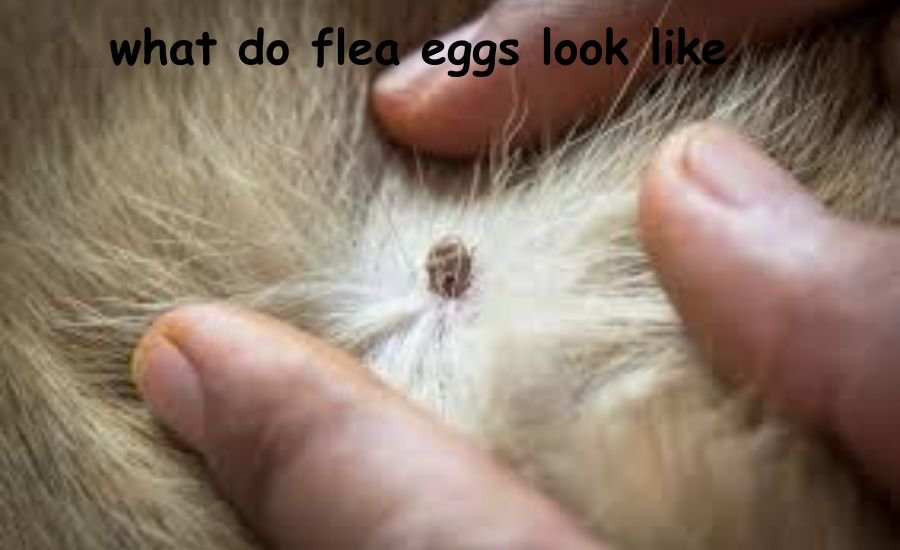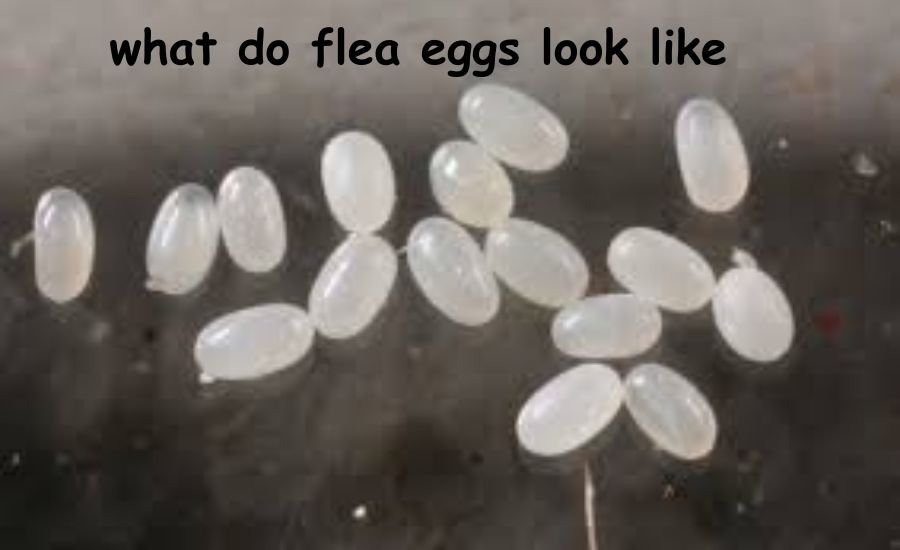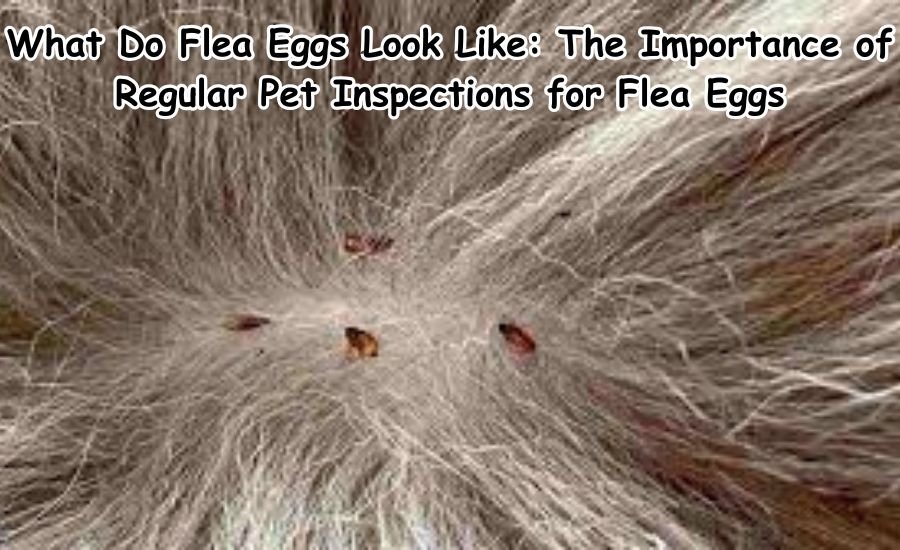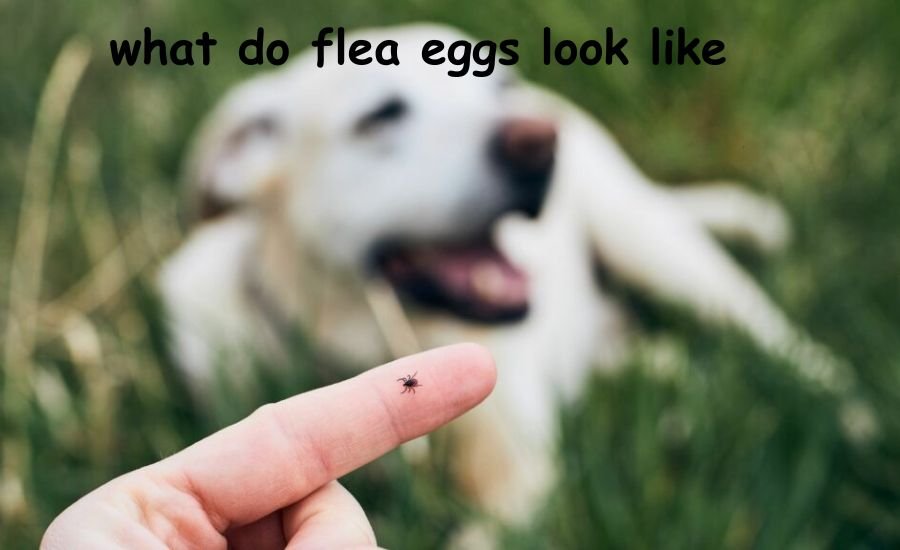If you’re a pet owner, you’ve probably heard about fleas and the troubles they cause. But have you ever wondered what do flea eggs look like? These tiny, oval-shaped eggs are the beginning of a flea infestation and are often mistaken for dust or dandruff. Understanding how to identify them is crucial for keeping your home and pets free from fleas.
Flea eggs might seem harmless, but they’re an important part of the flea’s life cycle. Adult fleas can lay up to 50 eggs daily, spreading them all over your home. This guide will walk you through everything you need to know about identifying and handling flea eggs to protect your pet and home effectively.
What Do Flea Eggs Look Like? A Basic Overview

If the question is “What Do Flea Eggs Look Like” then flea eggs are tiny and oval-shaped, about the size of a grain of sand. They have a smooth surface and are usually off-white or pale yellow in color. They might seem like dry skin flakes, but a closer look reveals their unique shape. These eggs are often hard to spot with the naked eye. They are usually found in clusters but can be scattered across various surfaces where your pet spends time. Spotting these eggs early can prevent an infestation from growing out of control.
Since flea eggs don’t stick to your pet’s fur, they tend to fall off and land on surfaces like carpets, bedding, and furniture. Being proactive and regularly cleaning these areas will help you prevent the flea population from multiplying. Additionally, flea eggs don’t stay in one place for too long. They can be carried by your pet from room to room, making it important to clean all areas your pet frequents. The quicker you spot flea eggs, the easier it will be to manage the infestation before it gets out of hand.
What Do Flea Eggs Look Like: Where Are Flea Eggs Found in Your Home?
If the question is “What Do Flea Eggs Look Like” then flea eggs don’t stick to your pet’s fur like lice eggs. Instead, they fall off and scatter around your home. Common hiding spots include carpets, bedding, couches, and even cracks in floors. You might also find flea eggs on pet toys, under furniture, or in your car if your pet travels with you. Checking these areas regularly and maintaining a clean environment can help stop the eggs from hatching into larvae.
It’s also important to look in places where your pet spends a lot of time, such as their favorite resting spots. Flea eggs can hide in these areas, so regular cleaning and vacuuming are essential to preventing a flea infestation. In addition to these areas, flea eggs can sometimes be found in your pet’s favorite outdoor spots, such as a garden or backyard. Make sure to inspect these areas and clean them regularly if your pet spends time outside.
What Do Flea Eggs Look Like: How to Identify Flea Eggs on Your Pet
Flea eggs can blend into your pet’s fur, especially if they have light-colored coats. Run your fingers through their fur and look for tiny, oval-shaped particles that might resemble dandruff. Flea eggs are often found around the neck, belly, or tail base of your pet. Checking these areas during grooming sessions will help you catch the infestation early and treat your furry friend effectively.
A magnifying glass can be helpful for identifying flea eggs with more detail. If you find small, oval, off-white objects in your pet’s fur, you’re likely looking at flea eggs. Regular grooming and inspecting your pet’s skin can help prevent flea issues from becoming severe. Another way to check for flea eggs is by lightly brushing your pet’s fur over a white surface. This will help the eggs stand out and make it easier for you to spot them.
What Do Flea Eggs Look Like: What Makes Flea Eggs Different From Flea Dirt?
Flea eggs and flea dirt often appear together, but they are not the same. Flea dirt is flea excrement and looks like small black specks. When wet, it turns reddish-brown because it’s made of digested blood. Another way to differentiate flea eggs is by their texture. Flea dirt smears when pressed on a wet paper towel, while flea eggs remain intact. Learning to distinguish these will help you take the right steps to address the issue.
Flea eggs are smooth and oval, while flea dirt looks like tiny black pepper. By checking closely, you can tell which is which, helping you decide whether you need to treat your pet for fleas or clean your home. If you’re unsure, the best way to identify flea dirt versus flea eggs is by using a damp cloth. Flea dirt will leave a reddish stain, while eggs will not change when wetted. This can be a helpful trick when inspecting your pet or surfaces around the house.
What Do Flea Eggs Look Like: How Flea Eggs Compare to Other Parasite Eggs

If the question is “What Do Flea Eggs Look Like” then you might confuse flea eggs with other types of parasite eggs like lice or mites. The main difference is that lice eggs stick to hair strands, while flea eggs easily fall off.
Flea eggs are also larger and easier to spot than mite eggs, which are microscopic. If in doubt, a quick trip to your vet can help you identify what type of eggs you’re dealing with.
Since flea eggs are not sticky like lice eggs, they can be found scattered in areas your pet visits often. If you’re unsure, your vet can confirm whether the eggs you’ve found are from fleas or another parasite.
It’s important to identify the eggs correctly so you can treat the right type of parasite. Flea eggs are often the most common, but understanding their differences from other pests will help you address the problem more effectively.
What Do Flea Eggs Look Like: Why Do Flea Eggs Fall Off Pets?
Flea eggs have a hard outer shell and don’t cling to your pet’s fur like other parasites’ eggs. This allows them to spread quickly to carpets, bedding, and other surfaces. This shedding behavior means flea eggs can be found almost anywhere in your home. Regularly cleaning and treating areas where your pet sleeps and plays will reduce the chances of eggs hatching into larvae.
Because of this, flea eggs can easily hide in places you don’t regularly clean, such as under furniture or in the corners of rooms. To prevent the spread of these eggs, focus on cleaning these overlooked spots too. The fact that flea eggs fall off makes them hard to control, but not impossible. By vacuuming frequently, washing pet bedding, and keeping areas clean, you can keep flea eggs from hatching into full-grown fleas.
What Do Flea Eggs Look Like: How Long Does It Take for Flea Eggs to Hatch?
If the question is “What Do Flea Eggs Look Like” then flea eggs take about 2-12 days to hatch, depending on the environment’s humidity and temperature. Warmer, more humid conditions speed up the process. After hatching, flea larvae feed on organic matter, including flea dirt. Breaking this cycle early by vacuuming and cleaning frequently will keep the infestation under control.
The quicker you remove flea eggs, the less chance you’ll have of an infestation. By vacuuming regularly and using flea treatments, you can stop fleas from completing their life cycle in your home. Remember that flea eggs can hatch as soon as they fall off your pet, so treating both your pet and your home is essential. If you don’t act fast, the problem can escalate quickly.
What Do Flea Eggs Look Like on Furniture?
If the question is “What Do Flea Eggs Look Like” then on furniture, flea eggs can resemble tiny grains of sand or salt. They are usually found in the crevices of cushions or under blankets where your pet rests. They can also be hidden in the seams of upholstery, making them harder to spot. Using a vacuum with attachments for crevices is the best way to remove these eggs effectively.
Checking every corner and under cushions will help you locate flea eggs. These small, oval-shaped eggs can be hard to see, but a careful inspection will ensure that they don’t hatch into a new generation of fleas. Additionally, using a flashlight can help illuminate these tiny eggs, making them easier to spot in dimly lit areas of your furniture.
What Do Flea Eggs Look Like:How to Remove Flea Eggs From Carpets and Rugs
Vacuuming is the most effective way to remove flea eggs from carpets and rugs. Use a vacuum with strong suction and empty it outside after cleaning. Focus on high-traffic areas and spots where your pet sleeps or plays. Steam cleaning carpets and rugs can provide an additional layer of protection by killing eggs and larvae instantly.
Make sure to vacuum not only the floors but also any rugs or mats where flea eggs may be hiding. Steam cleaning carpets once or twice a month will ensure that any leftover eggs won’t hatch. Pay special attention to the edges of carpets and under furniture, as flea eggs often collect in these places. Regular cleaning ensures that you’re disrupting the flea life cycle and preventing future infestations.
What Do Flea Eggs Look Like: How to Prevent Flea Eggs in the Future

The best way to prevent flea eggs is to use flea prevention products on your pets. Regular grooming and inspections can also catch flea eggs before they spread. Combining preventive treatments with thorough cleaning ensures that flea eggs don’t get a chance to hatch. Setting reminders for flea medication will help you stay consistent.
Flea eggs can appear at any time, especially during the warmer months. Preventing future infestations involves using preventative treatments year-round, even when fleas aren’t visible. In addition to treating your pet, consider flea-proofing your home by cleaning your floors, carpets, and furniture regularly.
Things You Have To Know: Cbum-age-surprising-facts-you-didnt-know
What Do Flea Eggs Look Like: The Life Cycle of Fleas and Flea Eggs
If the question is “What Do Flea Eggs Look Like” then flea eggs are the beginning of a flea’s life cycle. Fleas start as eggs, hatch into larvae, turn into pupae, and finally mature into adult fleas. Understanding the flea life cycle helps you target the right stage with treatment. Treating both your pet and your home is necessary to stop the cycle and prevent future infestations.
Flea eggs alone don’t cause much trouble, but once they hatch, they turn into larvae and eventually adult fleas. Regular cleaning and treatment of both your pet and home are essential for long-term control. Being proactive with flea prevention is key. By breaking the flea life cycle early, you can stop adult fleas from multiplying and keep your home free of these pests.
What Do Flea Eggs Look Like: Do Flea Eggs Always Lead to Fleas?
Not every egg will lead to an infestation, but the chances are high if they’re not dealt with. Flea eggs that fall off your pet can easily hatch and cause new fleas to emerge. The key to stopping fleas from developing is to act quickly. Regular cleaning and treating your pet with flea medication can break the flea life cycle and keep your home flea-free.
If flea eggs are left untreated, they can hatch into larvae and eventually adult fleas. Consistent cleaning and preventative care are the best ways to make sure that you don’t deal with a repeat infestation. By staying vigilant and treating both your pet and your home, you can reduce the chance that flea eggs will develop into a full-blown infestation.
What Do Flea Eggs Look Like: How to Treat Flea Eggs in the Environment
Treating flea eggs in the environment is just as important as treating your pet. Regular vacuuming and washing pet bedding will help remove flea eggs from your home. Steam cleaning carpets and upholstery is another way to kill flea eggs and larvae. These treatments will ensure that the flea population doesn’t have a chance to grow.
By paying attention to all areas where your pet spends time, you can target flea eggs before they hatch. Cleaning and vacuuming your home regularly will keep flea eggs from maturing into adult fleas. Flea treatment should include both your pet and your home. A combined approach ensures that all aspects of the flea life cycle are disrupted and prevents reinfestation.
What Do Flea Eggs Look Like: The Importance of Regular Pet Inspections for Flea Eggs

Regularly inspecting your pet’s fur is one of the easiest ways to spot flea eggs. Look for tiny, oval, off-white specks that resemble dandruff. Check the areas where fleas are most likely to be found: around the neck, tail, and belly. Using a flea comb can help you remove flea eggs before they fall off and spread around your home.
Early detection can prevent a flea infestation from becoming severe. The quicker you spot flea eggs on your pet, the sooner you can start treatment. By consistently checking your pet during grooming sessions, you can catch fleas before they cause discomfort or spread throughout your home.
What Do Flea Eggs Look Like: The Role of Flea Eggs in Infestations
If the question is “What Do Flea Eggs Look Like” then flea eggs are the foundation of any flea infestation. Adult fleas may be visible, but their eggs and larvae are often hidden. Since fleas lay dozens of eggs daily, even a few missed eggs can lead to a new infestation. Consistent cleaning and treatment are necessary to break the life cycle for good.
Flea eggs can be the source of future infestations if not properly handled. The quicker you take action by treating both your pet and environment, the better chance you have of preventing fleas from returning. By understanding how flea eggs contribute to infestations, you can take a more proactive approach to managing fleas. The key is treating both the eggs and larvae, not just the adult fleas.
Conclusion
In conclusion, knowing what do flea eggs look like is very important if you want to keep your home and pets free from these pesky parasites. Flea eggs are tiny, oval-shaped, and usually off-white or pale yellow, making them easy to miss unless you take a closer look. Understanding where these eggs are found—like on your pet’s fur, bedding, carpets, or furniture—can help you take action before they hatch into full-grown fleas.
Remember, If the question is “What Do Flea Eggs Look Like” then flea eggs can fall off your pet and spread all over the house. This makes it important to clean all areas your pet frequents, including their bed, furniture, and even your car. Vacuuming often, using steam cleaning, and washing pet bedding regularly are some of the best ways to remove flea eggs from your home. If you spot any flea eggs on your pet, be sure to treat them right away. The quicker you act, the less chance the fleas have to multiply. So, always be alert and proactive.
Read You Have To Know: Unlocking-good-digestive-health-with-oshi-health
FAQs
What do flea eggs look like?
Flea eggs are tiny, oval, and about the size of a grain of sand. They are usually white or pale yellow and are often mistaken for dandruff or dirt. These eggs are not sticky, so they often fall off into your home environment.
Where do flea eggs come from?
Flea eggs come from adult fleas that lay them on your dog or in their environment. The eggs then fall off into bedding, carpets, and other areas your pet frequents.
Can flea eggs be seen with the naked eye?
If the question is “What Do Flea Eggs Look Like” then flea eggs are visible to the naked eye but are very small—about the size of a grain of sand. However, they can be difficult to spot unless you look closely.
What do flea eggs look like compared to other pests?
Flea eggs are oval, white, and smooth, unlike tick or lice eggs, which are usually larger or cling tightly to fur. Mite eggs, on the other hand, are microscopic and hard to see.
Can flea eggs be harmful to humans?
Flea eggs themselves are not harmful to humans, but fleas that hatch from them can cause itching, allergic reactions, and even transmit diseases. It’s important to control flea infestations.
Do flea eggs stay on my dog?
No, flea eggs usually fall off your dog and land in the surrounding areas like their bedding or the floor. This is why cleaning these areas is so important in controlling flea infestations.
How can I prevent flea eggs from hatching?
If the question is “What Do Flea Eggs Look Like” then use flea prevention treatments for your dog, clean your home regularly, and wash your pet’s bedding frequently. Flea prevention will stop fleas from laying eggs, helping to avoid an infestation.









